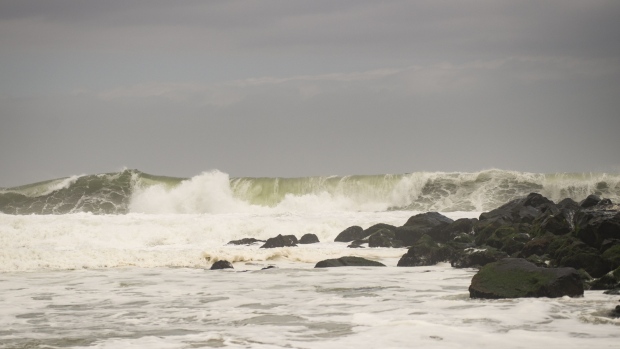Aug 1, 2020
Hurricane Isaias moves toward COVID-stricken Florida coast
, Bloomberg News

More than two million homes and businesses have lost power along the East Coast as Tropical Storm Isaias swirled through New York and the Northeast, killing a man in Queens, closing the Verrazzano Bridge and snapping power lines.
The worst of the storm had faded in New York City by late afternoon, leaving gusty winds and water still rising along the seashore. Earlier, seven tornadoes were reported across Maryland, Delaware and New Jersey and at least 18 were tallied Monday. They injured two people, flipped cars, damaged homes and tore limbs from trees, according to the U.S. Storm Prediction Center. The threat will spread across New England later.
Isaias, which made landfall on Monday in North Carolina, is the Atlantic’s ninth storm and fifth to hit the contiguous U.S. this year, the fastest that both those milestones have been achieved in records dating to 1851. Forecasts called for an active hurricane season surpassing the long-term average of 12 storms in a single six-month season, which enters its traditionally most-active phase from the end of August through September.
With winds of 65 miles (105 kilometres) per hour, Isaias held onto much of its strength as it pushed by Albany at 5 p.m. local time, the National Hurricane Center said.
New Jersey was hardest hit in terms of power outages, with at least 1.3 million customers in the dark. In New York, more than 560,000 customers were without service, mostly in Westchester County, the Hudson Valley and on Long Island. The outages are hitting at an especially difficult time as millions work from home instead of commuting to office buildings, which often have back-up generators.
Temporary flood barriers and sandbags were deployed in New York City, particularly in the Wall Street area, to defend against the storm thrusting sea water into streets. The Verrazzano Narrows Bridge was closed and traffic limited on the George Washington, which connects New York and New Jersey. At least 2,000 trees were toppled in New York.
“Some of the storm has passed, but we’re still going to have these winds for a few more hours,” Mayor Bill de Blasio said in an interview with WINS radio.
Wind strength has fluctuated in the last few days. Isaias briefly regained hurricane power as it came ashore in North Carolina late Monday, but from here on it will continue to weaken as it moves over land, eventually falling apart in northern Canada by Thursday.
The storm didn’t have much impact on cotton, corn and soybean crops in North Carolina and across the Mid-Atlantic.
Nuclear Shutdown
Duke Energy Corp.’s Brunswick nuclear plant was in the path of the storm when it hit land in North Carolina Monday night. Unit 1, which had been ramping down for maintenance, was taken offline after losing backup power supplies, said Roger Hannah, a spokesman for the Nuclear Regulatory Commission in Atlanta.
The other unit didn’t lose backup supplies and was operating at full capacity. The only other reactors in the immediate path of the storm were at Dominion Energy Inc.’s Surry Power Station in southeastern Virginia, and both of those were operating at full capacity at 8:10 a.m., he said.
Isaias didn’t pose a threat to any major oil refineries or platforms.
It’s possible that Isaias will leave about US$2 billion in damage and losses in its wake, said Chuck Watson, a disaster modeler with Enki Research. If Covid hadn’t discouraged tourism and more people were working in their offices, then the cost would have certainly been higher, he said.
Overnight Isaias will push north into Canada passing east of Montreal and is forecast to be absorbed by a larger weather system in a few days. It killed at least four people on its sweep through the Caribbean and then up the U.S. East Coast.
Forecasters are also watching a second potential storm in the eastern Atlantic, which has a 30 per cent chance of developing, down from 60 per cent earlier.
--With assistance from Jim Wyss, Serene Cheong, Gerson Freitas Jr., Ben Sharples, Andrew Janes and Elise Young.